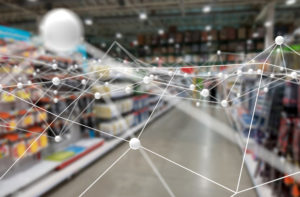By Courtney Wylie, VP of Product and Marketing for Mention Me
NDA is talking to experts in different digital sectors to hear their predictions for 2019. Referral marketing platform Mention Me, which raised $7m in 2018, works with over 300 brands, tapping into the booming consumer appetite for referral mechanics.
The pace of growth in ecommerce is phenomenal and shows few signs of slowing.
Though the scale and speed of change can seem dizzying to even the most seasoned of digital marketers, the rewards of keeping up with consumer behavioural habits, the latest available technologies, and industry best practices, will be worth the effort in today’s digital-first economy.
Here are our predictions for six trends in ecommerce in 2019:
Product search and discovery: voice assistant tech grows in impact and influence
Consumer expectations have rapidly matured in recent months in relation to how people research and find relevant products. The most notable breakthrough being voice search, which we think should be considered a key strand of every brand’s consumer-led marketing strategy in 2019.
Products like Google Assistant and Amazon’s Alexa are no longer considered early adopter playthings – they’ve broken into the mainstream of consumer behaviour.
According to research reports, over 30 percent of 14 to 17 year olds are regularly using voice assistants, with just under 25 per cent of 18 to 34 year olds reporting the same.
Whilst the user experience is still far from perfect (with comical/embarrassing results on occasion), voice assisted technology will continue to grow and reshape the ecommerce landscape in 2019.
Greater emphasis on ‘micro moment’ marketing
Back in 2015, Google put forward the idea of micro moments changing the rules of consumer engagement in a mobile-first era. With the normalisation of things like voice assistants, we think this ‘mental model’ will gain even greater adoption in 2019.
Google defines micro moments as the repeated times during the course of daily life when people reflexively turn to their devices – increasingly smartphones, now also voice assistant products – to act on a need to learn, do, discover, watch, or buy something.
In other words, the days of ‘push marketing’ where companies could project one-way advertising onto passive audiences are being replaced by something far more nuanced. Today, consumers — armed with an unlimited amount of information at their fingertips – call the shots.
Our Customer Advocacy in 2019 report revealed that for the second year running, trustworthiness is the top-ranked attribute that customers seek in brands. We very much see the idea of ‘micro moments’ as falling under the same principles of trust-based marketing: meeting the consumer where they are, giving them the value they need at just the right time and place, on their terms.
Personalised omnichannel marketing continues to evolve – but remains a challenge for many
Personalisation has been a hot topic for a while now.
However, delivering truly personalised journeys across multiple channels is still proving to be a major challenge for many brands, and this will probably continue to be the case in 2019.
An Evergage report found that only 27% of marketers surveyed are syncing half or more of their channels. Whilst 27% don’t have any of their channels connected at all.
Budgetary challenges, poor data quality, and an inability to create consistency across internal organisational silos are often cited as the main obstacles to putting personalised omnichannel marketing into practice.
Despite this, multi-channel personalisation remains important as an aspiration to the majority of brands – and rightly so.
Automated customer support gains in acceptance, usage and success
Poor customer service costs economies billions each year. Automated customer support solutions such as chatbots, are helping online retailers solve that problem. As with voice assistants, chatbots are far from perfect, but they’ve enabled companies of all sizes to offer previously unattainable levels of service, such as 24/7 availability.
Although chatbots and the like were initially met with consumer scepticism, their value is now starting to shine through.
For example, an artificial Intelligence customer service assistant developed for the Republic of Estonia’s e-Residency organisation is said to have successfully dealt with 45% of customers’ questions without human intervention.
Gartner boldly predicts that 85% of all customer interactions will be handled without the need for a human agent by 2020.
One thing’s for sure: chatbots and automated customer support assistance is only going to grow stronger in usage and effectiveness in 2019.
Frictionless checkout and payment process – the holy grail for retailers
Whilst many brands focus their efforts on marketing aspects of the buyer’s journey (getting feet through the door and engaging in products), many still overlook the effectiveness of the final, and most crucial, stage: checkout and payment.
According to the Baymard Institute, 68% of all online shoppers abandon their carts.
We expect to see ecommerce retailers continue to up their game in 2019, concentrating on an ever growing set of cart optimisation tools, tactics and strategies to grow customer conversion.
The future of delivery is here (yes, drones)
Consumers are impatient. Online, demand for convenience and instant gratification is insatiable. According to research from on-demand delivery platform Stuart, a whopping 72% of UK consumers said that they’d spend significantly more online if retailers were able to deliver products on the same day their order is placed.
Not all retailers are in a position to emulate Amazon’s Prime Air drone delivery service, capable of delivering products within 30 minutes of purchase. But we expect to see further roll out and experimentation with delivery technologies in 2019 as retailers scramble to satisfy customer demand for lightning speed service.
Conclusion
The world of e-commerce continues to keep retailers on their toes. With a bleak outlook in consumer retail spending reflected in post Black Friday and Christmas profit announcements, retailers need to keep up with this momentum.
With a range of problems still to be solved and innovations yet to be leveraged to their full potential, there’s a lot to look forward to as we progress through 2019.
Read our Influencer Marketing Predictions 2019 here.







